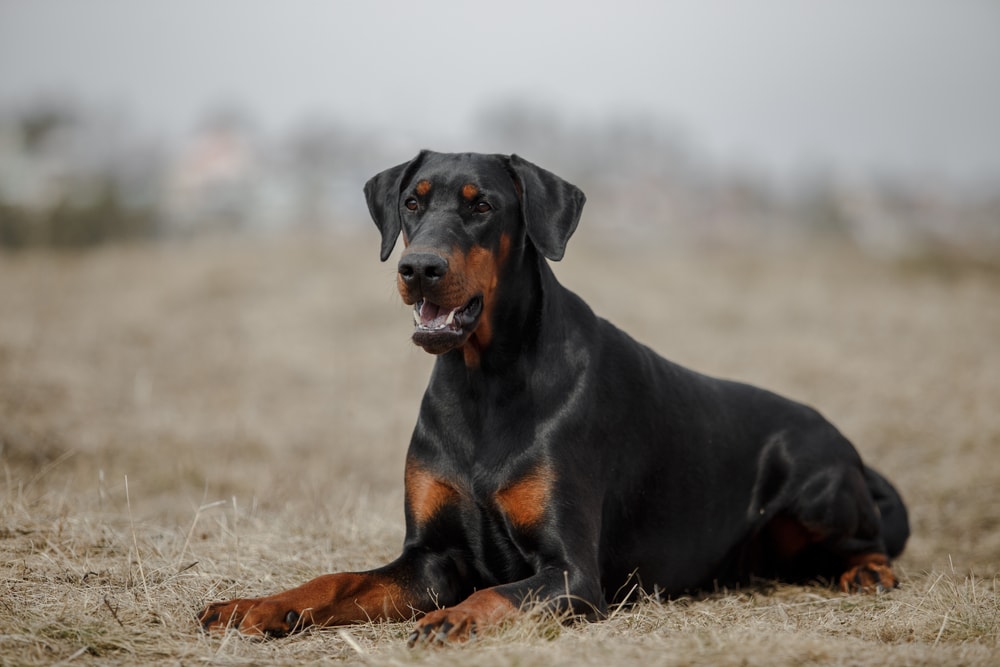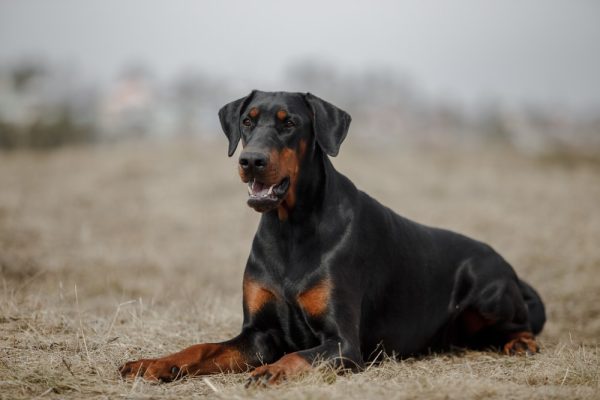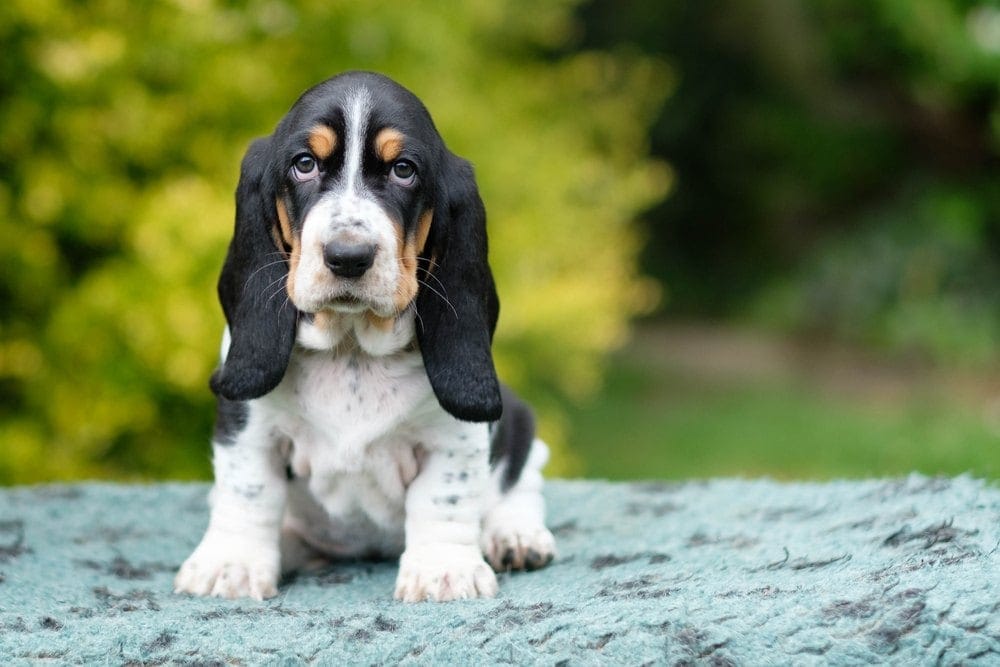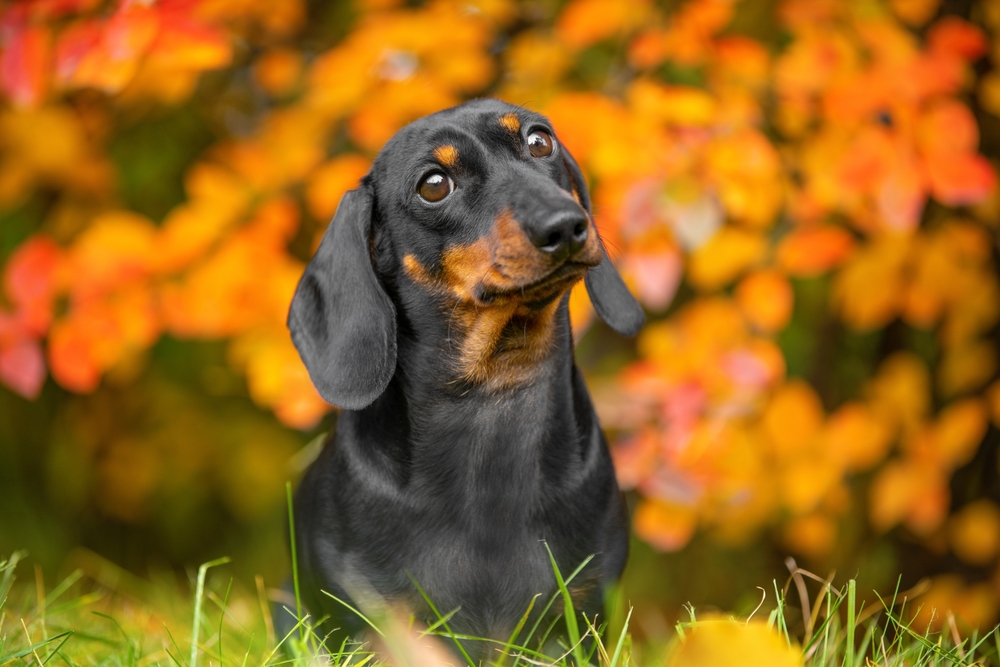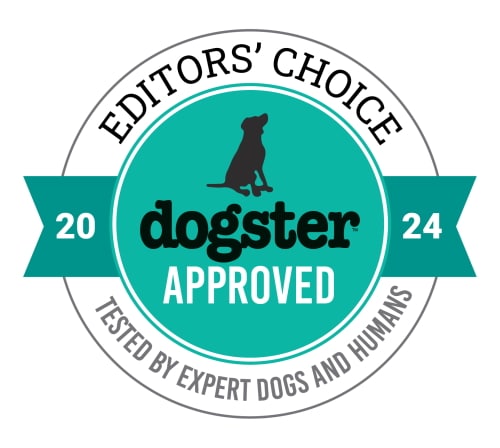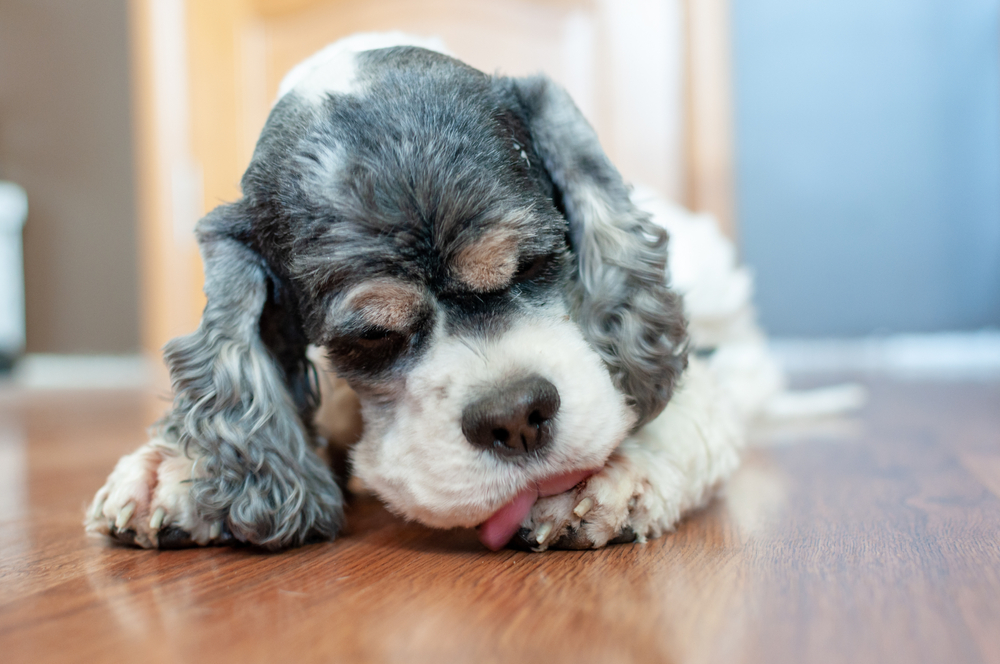Click Below to Skip Ahead
The Doberman Pinscher is a working-class dog breed with an intimidating appearance and reputation that precedes them. While the general public often considers them dangerous and aggressive, any Doberman Pinscher owner can tell you just how far from the truth this preconceived notion is. Dobermans are highly devoted, people-oriented dogs but require the right owners to thrive.
Read on to learn more about these beautiful dogs, including how to care for them and what to expect when you own one.
Breed Overview
Height:
26–28 inches
Weight:
60–100 pounds
Lifespan:
10–13 years
Colors:
Black, blue, red, fawn, rust
Suitable for:
Experienced dog owners looking for a highly active companion
Temperament:
Devoted, strong-willed, affectionate, intelligent, high-energy
No one knows exactly what breeds were used to create the Doberman Pinschers, though it’s thought that several large dogs, such as Rottweilers, German Pinschers, and Weimaraners were used to develop the breed. Doberman Pinschers were first recognized by the American Kennel Club (AKC) in 1908 and have consistently made the list of the top 20 most popular dog breeds from the AKC.
Doberman Pinscher Characteristics
Doberman Pinscher Puppies
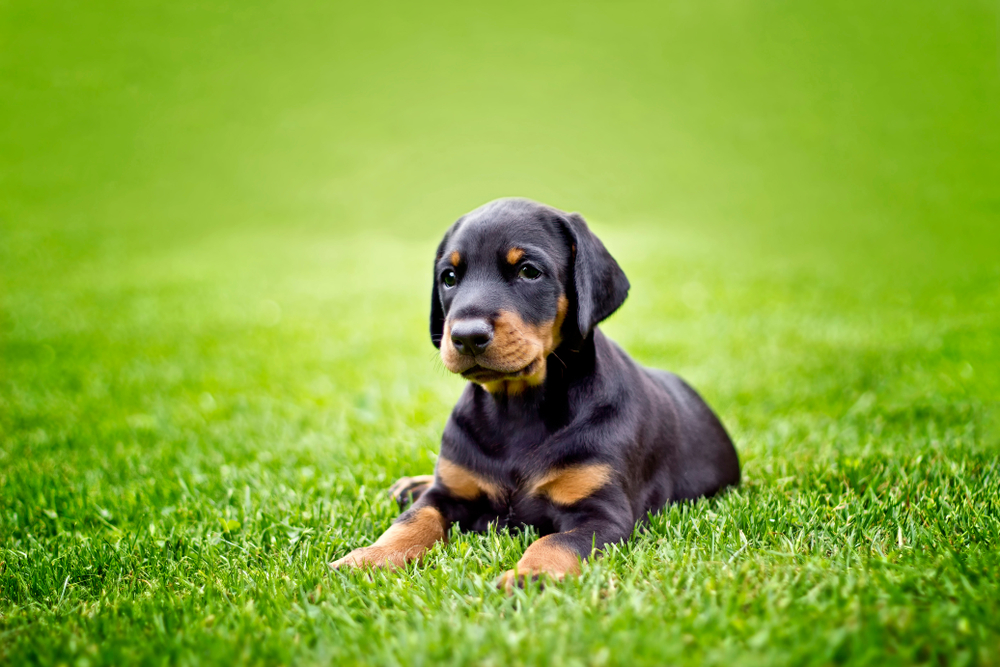
Since Doberman Pinschers are purebred dogs, it’s best to adopt one from a reputable breeder. Responsible breeders use the breed standard as a blueprint for producing quality puppies. They do not breed to turn a profit and are focused on ensuring they match each puppy with the right home. Responsible breeders will do the proper health testing to ensure the dogs they produce live long and healthy lives.
Google is a great place to start with finding the right breeder, but you’ll need to do your due diligence, too. Research each potential breeder carefully and be sure to meet with them to gauge whether they have the best interest of both the dog and you at heart.
Temperament & Intelligence of the Doberman Pinscher
Doberman Pinschers are loyal, alert, and highly intelligent dogs belonging to the working group. They’re very curious and energetic, so they have high activity requirements to stimulate them physically and mentally.
Dobermans are often stereotyped as having aggressive and ferocious attitudes. It is true that these dogs were originally bred for such traits and that they serve them well if they work in roles such as police dogs. However, modern breeders have reduced these traits throughout the years, leaving the resulting pups with a more even-natured temperament.
According to renowned psychologist and canine behavior researcher Stanley Coren, Doberman Pinschers are the fifth most intelligent dog breed in the obedience command training category. This makes them one of the most trainable dogs, especially in obedience competitions. This high intelligence, paired with the Doberman’s highly perceptive temperament, makes them well suited for police and military work.
Are These Dogs Good for Families? 👪
Doberman Pinschers can make fantastic family pets. They generally bond tighter to one specific human in their home, though this isn’t always true. They’re known for their loyalty and love for their human family members. However, this loyalty and devotion can make them weary around strangers. It’s important that Doberman owners put in a lot of time and effort socializing their puppies as soon as possible to make them better and more well-rounded as adults.
Doberman Pinschers have very high energy levels and are large, strong dogs, which may make them unsuitable for families with particularly young children. Even the sweetest and gentlest Dobermans can inadvertently inflict harm on their human siblings when they get excited.
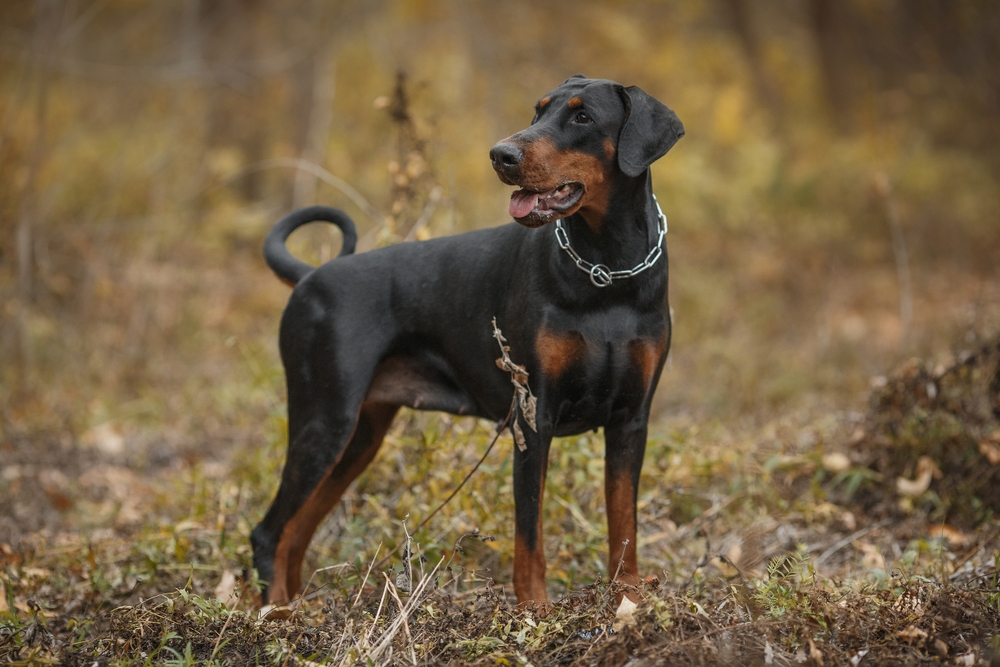
Does This Breed Get Along With Other Pets? 🐶 😽
Doberman Pinschers have a particularly strong prey drive, which may make them unsuitable for homes with small animals like cats or guinea pigs. However, a properly socialized Doberman Pinscher is capable of living alongside a cat harmoniously. A slow, deliberate introductory period and plenty of training and supervision would be necessary.
They do generally get along well with other dogs, though there may be some issues with same-sex aggression if you’re trying to introduce two Dobermans of the same sex together. This is particularly true if the two dogs are male. Early socialization in puppyhood is key in reducing the likelihood of this type of aggression.
Things to Know When Owning a Doberman Pinscher
Food & Diet Requirements 🦴
Doberman Pinschers, like all dogs, require a high-quality diet that’s easy to digest and palatable. Choose a commercially prepared kibble or wet food with an Association of American Feed Control Officials (AAFCO) label that deems the food appropriate for your pup’s life stage.
To reduce your dog’s risk of developing bloat (more about that under the “Health and Conditions” section), feed them twice per day instead of one large meal. When your dog is a puppy, they should eat more frequently.
As for quantity, the recommended caloric intake for your dog will depend on their size, metabolism, and activity level. We recommend speaking with your veterinarian to find serving sizes that are appropriate for your individual dog.
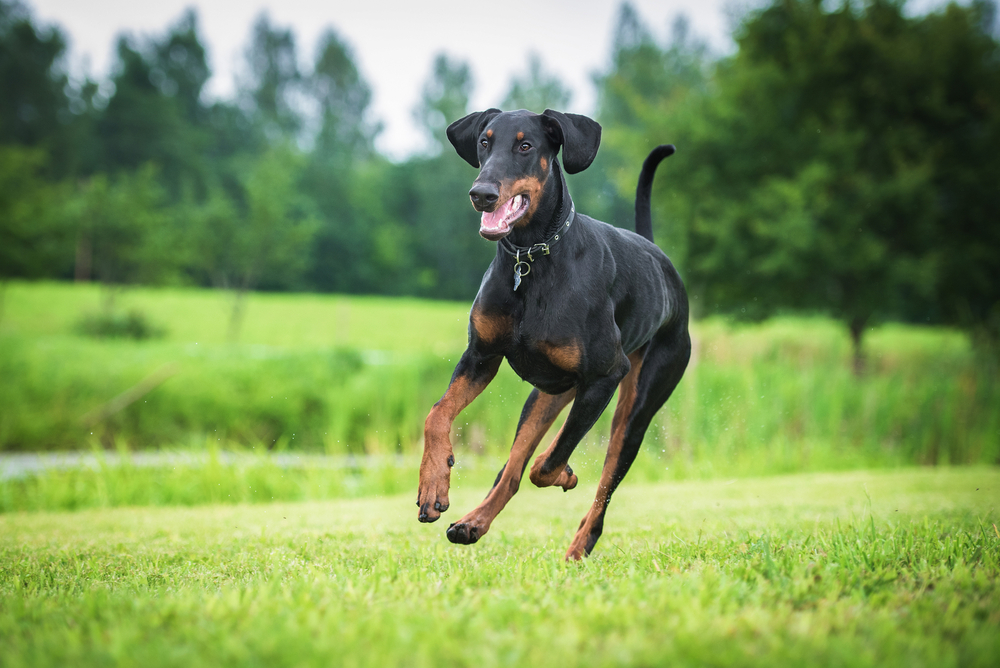
Exercise 🐕
Doberman Pinschers are highly active and energetic dogs that require a fair amount of exercise and stimulation to stay happy and healthy. Without the right amount of regular exercise, it’s not unusual for these pups to seek out their own forms of entertainment, which can lead to undesirable and destructive behaviors. Doberman Pinschers need around two hours of exercise daily to burn off their excess energy. It’s best to spread the exercise out throughout the day instead of doing two hours in one go.
Training 🎾
Doberman Pinschers are strong and powerful dogs that require a lot of exercise and training. Because they’re so smart, they thrive in obedience training, and doing so can be a great outlet for all their excess energy. As with all dogs, the sooner you begin socializing and training them, the better and more well-rounded they’ll be as adults.
Without consistent positive reinforcement training, Doberman Pinschers can become unmanageable and reactive.
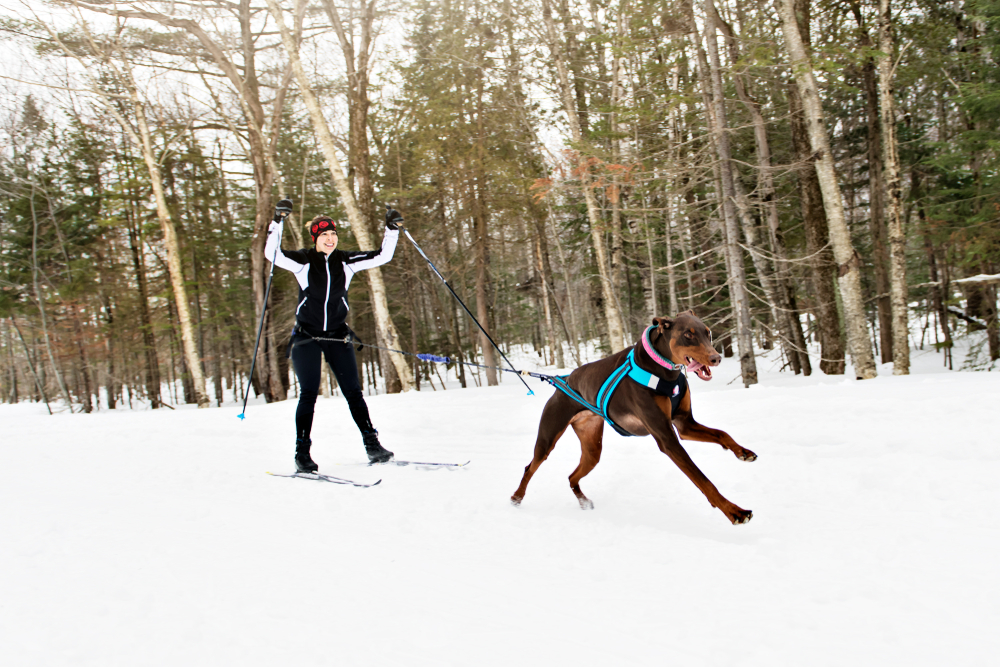
Grooming ✂️
Doberman Pinschers have short, smooth coats and can be moderate to heavy shedders. They should be brushed a few times a week to help manage shedding, but other than that, their grooming requirements are minimal. They don’t need to be bathed often, though they’ll need their nails trimmed monthly and their teeth brushed regularly. Ask your veterinarian or groomer to show you how to clean your Doberman’s ears properly to avoid damage and prevent potential issues.
Health and Conditions 🏥
Though Doberman Pinschers are a generally healthy breed, they are prone to developing certain health issues.
Their size and deep chests make them prone to gastric dilatation-volvulus (GDV), which is a form of bloat. This condition can develop rapidly and will require immediate veterinary care to prevent sudden death. GDV occurs when the stomach expands with food or gas and twists on itself, cutting off the blood supply to the organs.
Dilated cardiomyopathy (DCM) occurs when the heart muscle degenerates and cannot pump as required. This is a serious condition affecting Dobermans more than other breeds. It requires intensive treatment focused on slowing the progression of the disease and controlling symptoms.
Von Willebrand Disease (vWD)is a bleeding disorder seen more frequently in Dobermans than in other breeds. Though there is no cure, dogs with vWD can live a normal life as long as they receive appropriate care.
Hypothyroidism, hip dysplasia, and canine compulsive disorder are also commonly noted in Dobermans.
- Von Willebrand Disease
- Hypothyroidism
- Hip dysplasia
- Canine compulsive disorder
- Gastric dilatation-volvulus
- Dilated cardiomyopathy
Male vs Female
As with most dog breeds, the biggest difference between male and female Doberman Pinschers is the size. Males are generally between 26 and 28 inches, while females are a bit smaller, between 24 to 26 inches. As for weight, males will weigh anywhere between 75 and 100 pounds, while their female counterparts weigh between 60 and 90 pounds. Males are built bulkier and have more muscle mass, while females are generally slimmer and less muscular.
3 Little-Known Facts About the Doberman Pinscher
1. Dobermans were first bred by a German tax collector in the 1880s.
Karl Friedrich Louis Dobermann is credited with being the first breeder of the Doberman breed. He was a local tax collector in a town called Apolda in central Thuringia, Germany, though he also ran the dog pound in his village. He wanted to create a dog breed that was tough enough to protect him during his dangerous work in the seedy parts of his city.
2. While many breeders crop their Doberman puppy’s ears, it has no proven health benefits.
Ear cropping is a cosmetic procedure that requires surgically cutting away the dog’s outer ear to alter the ear’s shape. It’s done with scissors or a sharp blade and will require either sutures or surgical glue. Cropping is usually done on puppies when they’re between 6 to 12 weeks old.
When cropping became popular, it was originally done to reduce the risk of injury in dogs living violent lifestyles, such as those involved in dog fighting rings or bear baiting. While some proponents claim that the procedure reduces ear infections and injuries, no scientific evidence supports this.
Doberman Pinschers that have had the procedure will have ears that stand upright. Those that aren’t cropped as puppies will have naturally floppy ears.
3. Doberman Pinschers are often hired to do very important police and military work.
It’s not unusual to find Doberman Pinschers doing important police and military work. This highly versatile breed has been used as search and rescue dogs, therapy dogs, guardians, and scouts. They are equally great at being watchdogs and working as guide dogs for blind people.
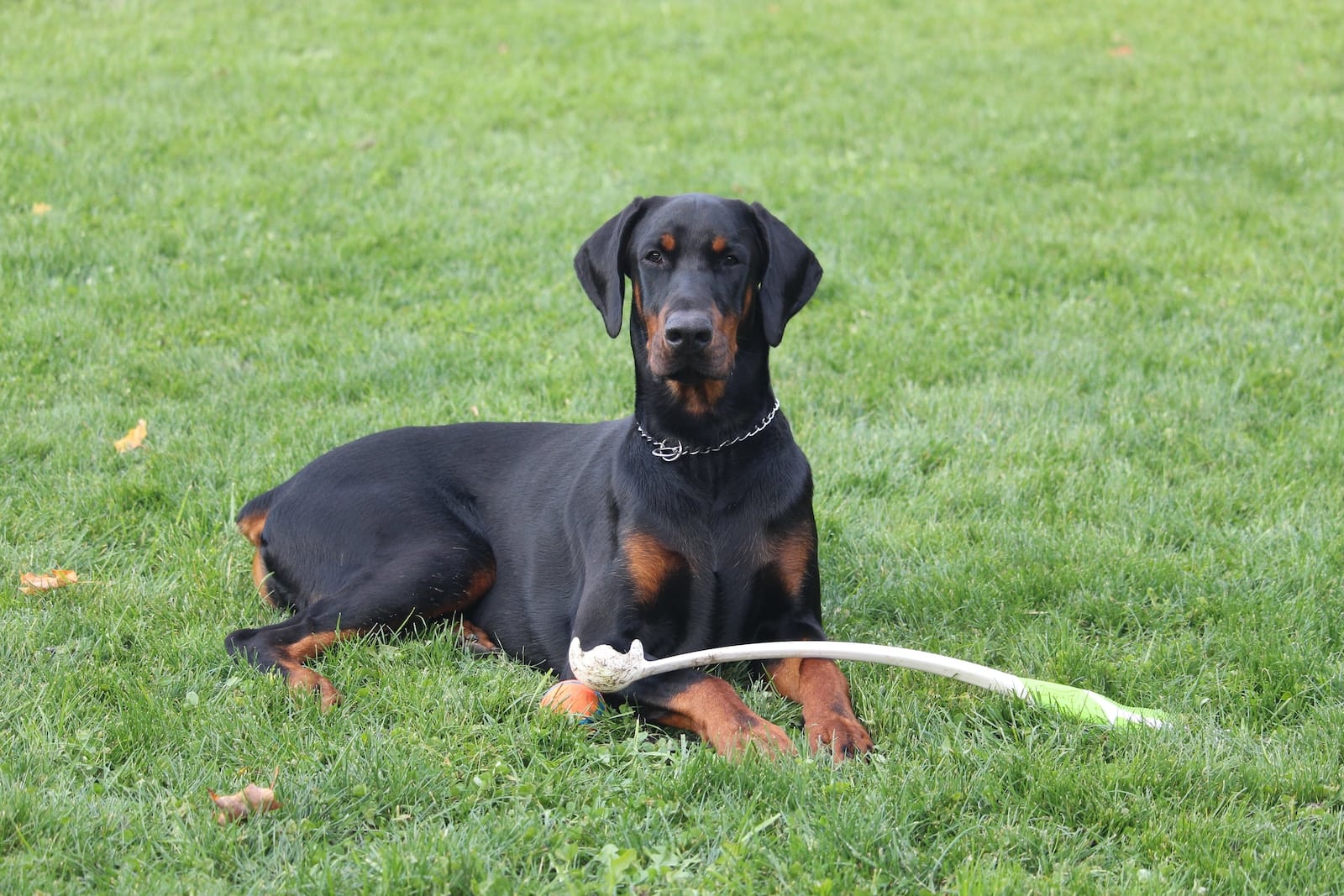
Final Thoughts
Though the Doberman Pinscher has a bad reputation, these dogs are exceedingly sweet and loyal under the right ownership. All potential owners should have a full understanding of the power and strength of the breed, as well as their high activity requirements, before choosing to adopt one. Two hours of exercise daily is the minimum. The more you can provide for your pet, the better.
As sweet as these dogs can be, it’s important to know that this is not a breed for first-time dog owners. They can be calm and well-tempered with the right training and socialization, but most newbies to the dog world will not have a good enough understanding of the Doberman’s needs to give them the life and care required. Additionally, because of their size and power, families with small children should wait until their kids are a little older before welcoming a Doberman into their homes.
Doberman Pinschers make great pets for active families and those with experience owning and training dogs. They need an environment where they won’t get bored and will be challenged mentally and physically daily. If this sounds like the right dog for you, you’ll be awarded a devoted, people-oriented, affectionate, and sweet pup who will look at you with stars in their eyes.
Featured Image Credit: elis aksenova, Shutterstock

